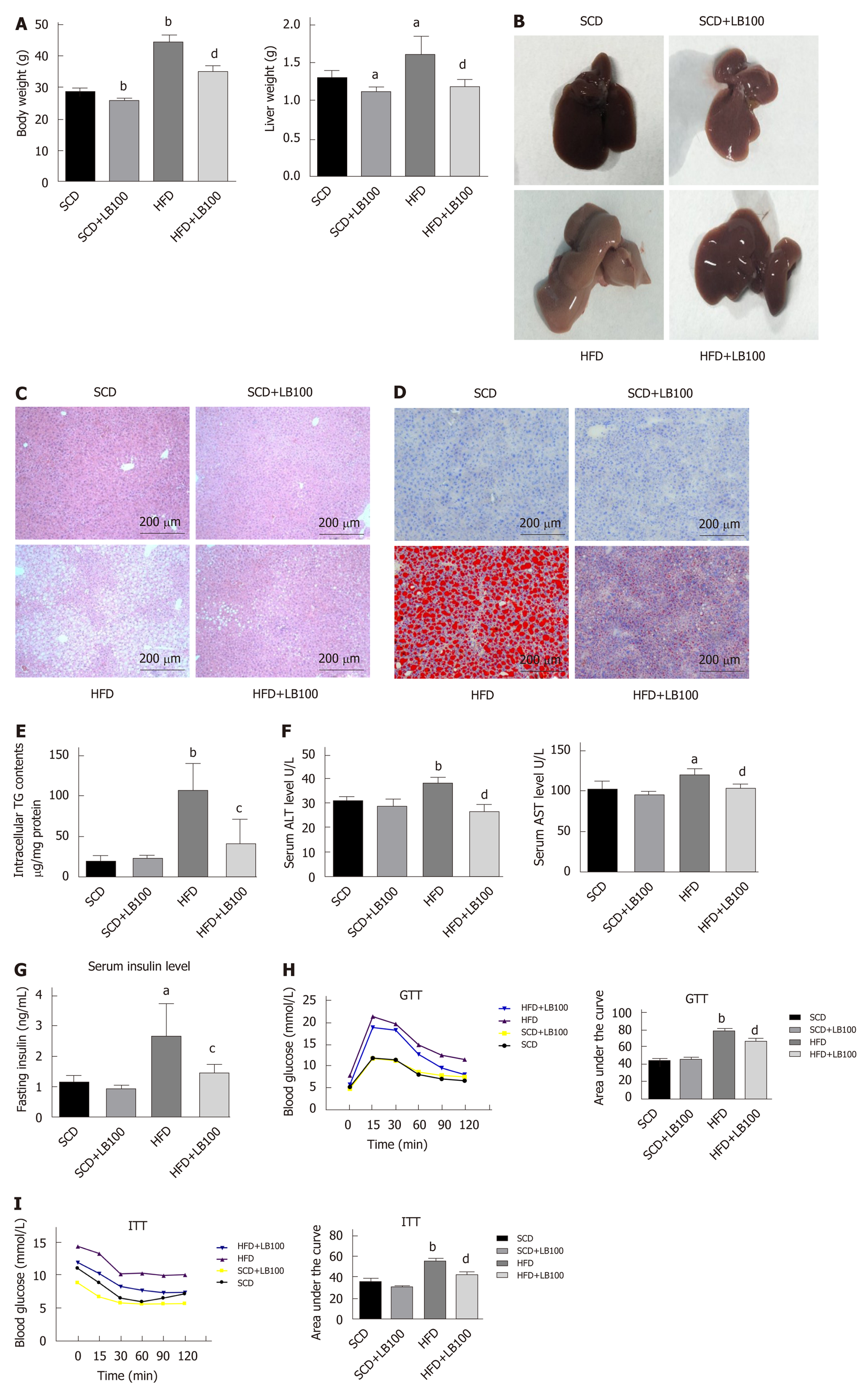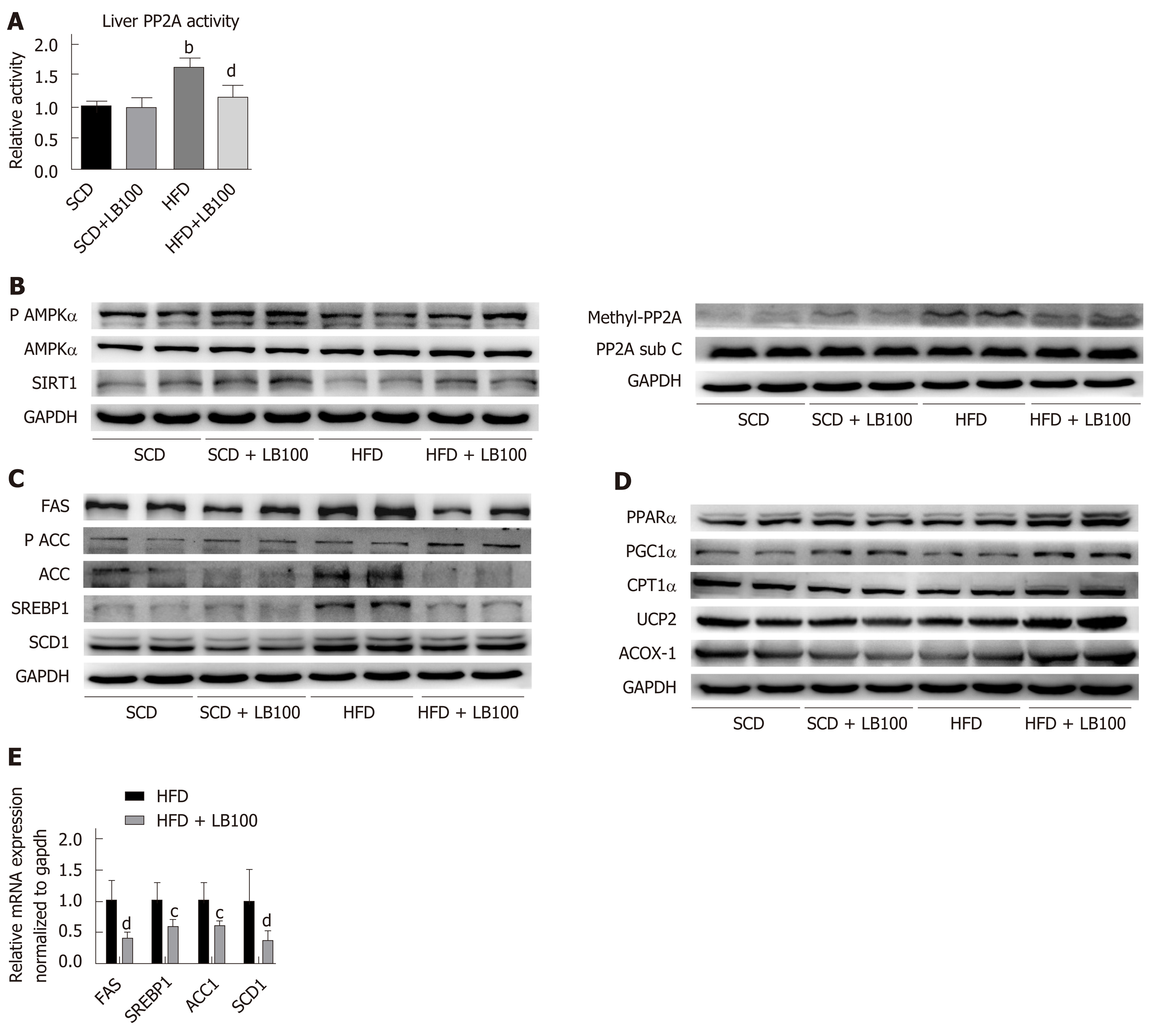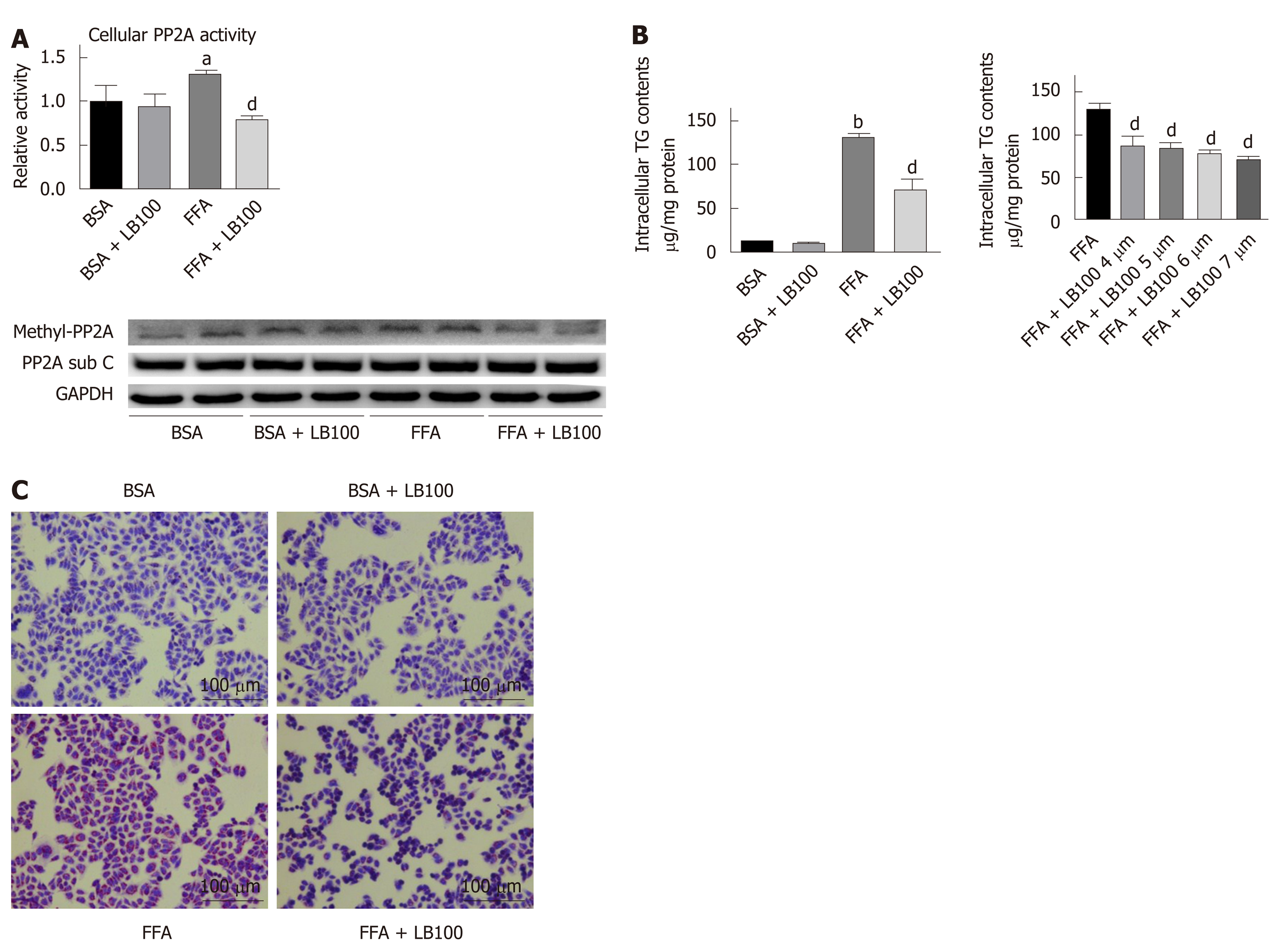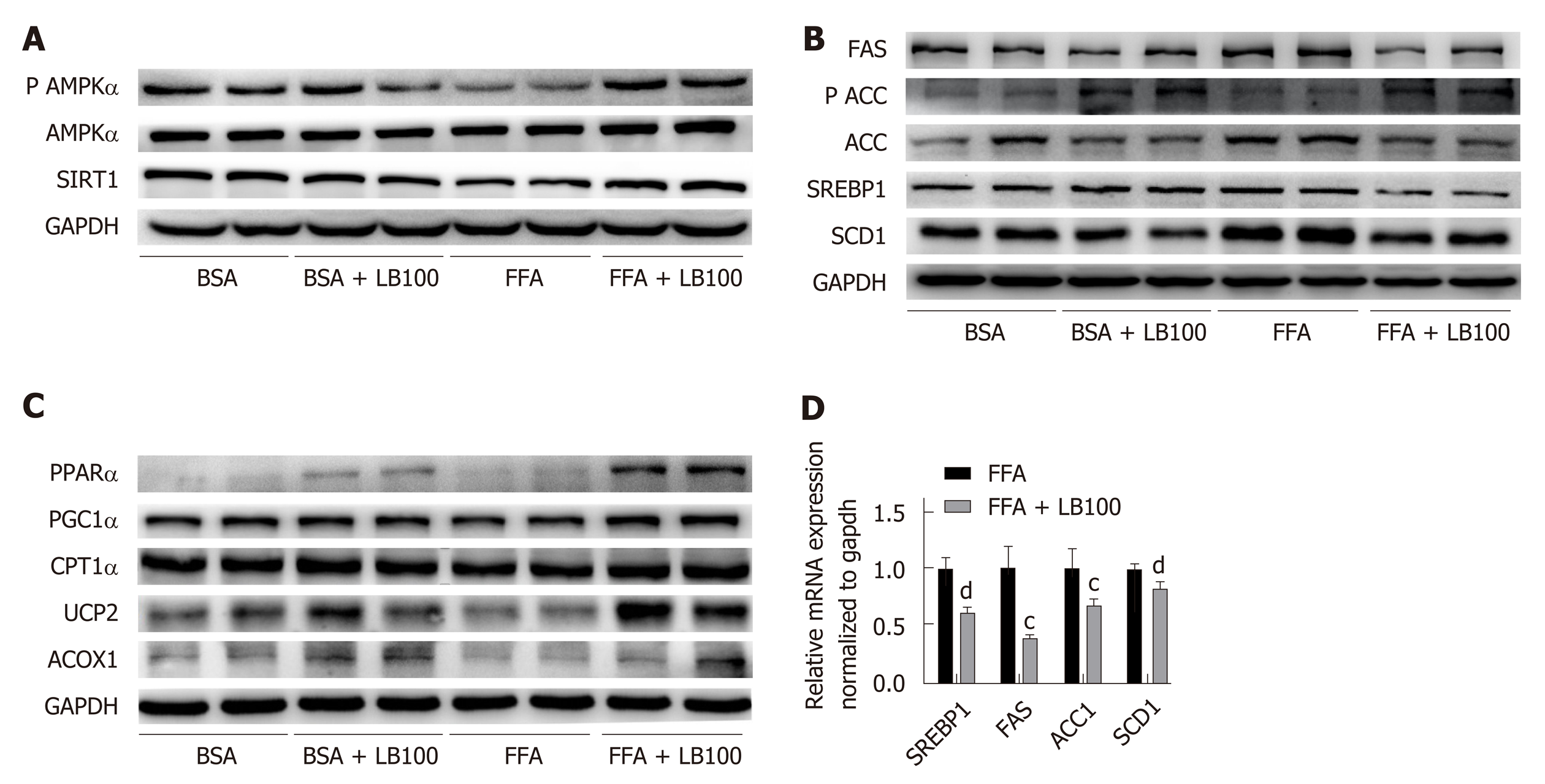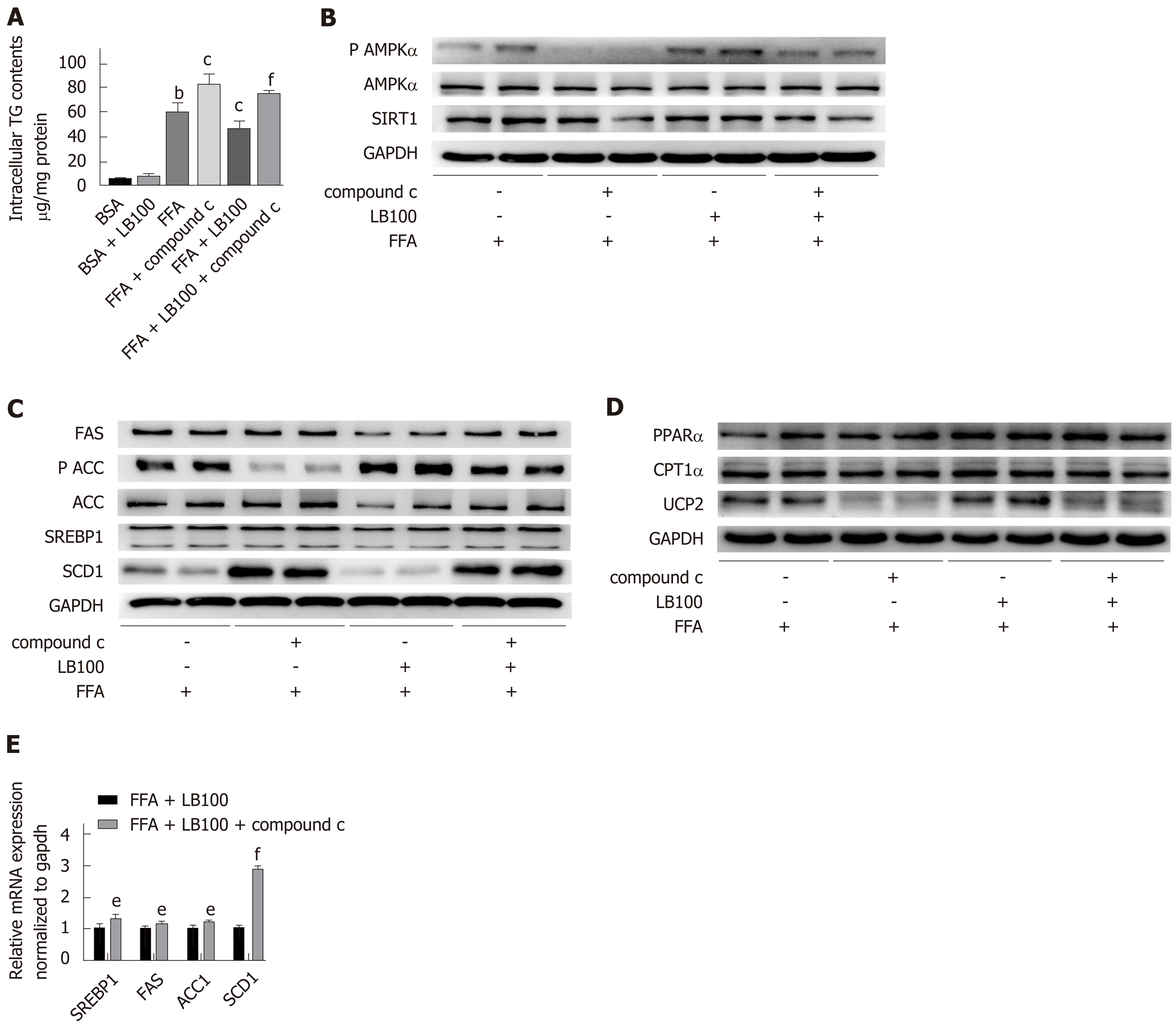Copyright
©The Author(s) 2019.
World J Gastroenterol. Dec 7, 2019; 25(45): 6607-6618
Published online Dec 7, 2019. doi: 10.3748/wjg.v25.i45.6607
Published online Dec 7, 2019. doi: 10.3748/wjg.v25.i45.6607
Figure 1 LB100 reduces body weight, ameliorates hepatic steatosis and attenuates liver injury in high fat diet-fed mice.
A: Body weight and liver weight on the final day; B: Macroscopic view of livers from the four groups of mice; C: Representative liver histological section images of the four groups of mice stained with hematoxylin and eosin; D: Representative liver histological section images of the four groups of mice stained with oil red O; E: Triglyceride content of livers in the four groups; F: Serum levels of alanine aminotransferase and aspartate aminotransferase; G: Serum levels of insulin; H: Glucose tolerance test; I: Insulin tolerance test of mice fed with standard chow diet (SCD) or high fat diet (HFD) for 14 or 15 wk. Scale bar in panel represents 200 μm. Data are presented as the mean ± standard deviation. aP < 0.05, bP < 0.01 vs SCD mice; cP < 0.05, dP < 0.01 vs HFD mice. HFD: High fat diet; TG: Triglyceride; ALT: Alanine aminotransferase; AST: Aspartate aminotransferase; GTT: Glucose tolerance test; ITT: Insulin tolerance test; SCD: Standard chow diet.
Figure 2 LB100 inhibits serine/threonine protein phosphatase 2A activity, upregulates the expression of proteins involved in fatty acid β-oxidation, downregulates the protein levels of lipogenesis genes, and activates the AMPK/Sirt1 signaling pathway in the liver tissues of high fat diet-fed mice.
A: Serine/threonine protein phosphatase 2A (PP2A) activity tested by a commercial assay (upper), protein expression of methylated PP2A and PP2A C subunit (lower) of mouse livers from the four groups; B: Western blot analysis of phosphorylated AMP-activated protein kinase α, phosphorylated AMP-activated protein kinase α, and Sirtuin 1; C: Proteins involved in lipid synthesis, such as fatty acid synthase (FAS), acetyl-CoA carboxylase (ACC), sterol regulatory element-binding protein 1 (SREBP1) and stearoyl-CoA desaturase-1 (SCD1); D: Proteins involved in fatty acid β-oxidation, such as peroxisome proliferator-activated receptor α, peroxisome proliferator-activated receptor gamma coactivator-1α, carnitine palmitoyltransferase 1α, uncoupling protein 2, and acyl-CoA oxidase 1; E: Gene expression levels of SREBP1, FAS, ACC1 and SCD1 were determined using real-time PCR. Three independent experiments were analyzed, and the data are presented as the mean ± standard deviation. aP < 0.05, bP < 0.01 vs standard chow diet mice; cP < 0.05, dP < 0.01 vs HFD mice. PP2A: Serine/threonine protein phosphatase 2A; P AMPK α: Phosphorylated AMP-activated protein kinase α; Sirt1: Sirtuin 1; FAS: Fatty acid synthase; ACC: Acetyl-CoA carboxylase; SREBP1: Sterol regulatory element-binding protein 1; SCD1: Stearoyl-CoA desaturase-1; PPARα: Peroxisome proliferator-activated receptor α; PGC1α: Peroxisome proliferator-activated receptor gamma coactivator-1α; CPT1α: Carnitine palmitoyltransferase 1α; UCP2: Uncoupling protein 2; ACOX1: Acyl-CoA oxidase 1; SCD: Standard chow diet; HFD: High fat diet.
Figure 3 LB100 inhibits serine/threonine protein phosphatase 2A activity and decreases free fatty acid-induced lipid accumulation in L02 cells.
Free fatty acid (1 mmol/L)-stimulated L02 cells were treated with LB100 (6 μmol/L) or vehicle for 24 h. A: Serine/threonine protein phosphatase 2A (PP2A) activity tested by a commercial assay (upper), protein expression of methylated PP2A and PP2A C subunit (lower) of L02 cells in the different groups; B: Intracellular triglyceride content in L02 cells; C: Representative image of oil red O staining of L02 cells in the different groups. Scale bar in panel represents 100 μm. Data are presented as the mean ± standard deviation. aP < 0.05, bP < 0.01 vs bovine serum albumin group; cP < 0.05, dP < 0.01 vs FFA group. FFA: Free fatty acid; PP2A: Serine/threonine protein phosphatase 2A; TG: Triglyceride; BSA: Bovine serum albumin.
Figure 4 LB100 downregulates the protein levels of lipogenesis genes, upregulates the expression of proteins involved in fatty acid β-oxidation, and activates the AMPK/Sirt1 signaling pathway in L02 cells.
A: Protein expression levels of phosphorylated AMP-activated protein kinase α, AMPKα and Sirtuin 1 were detected by western blot analysis; B: Western blot analysis of proteins involved in lipid synthesis, such as fatty acid synthase (FAS), acetyl-CoA carboxylase (ACC), sterol regulatory element-binding protein 1 (SREBP1), and stearoyl-CoA desaturase-1 (SCD1); C: Proteins involved in fatty acid β-oxidation, such as peroxisome proliferator-activated receptor α, peroxisome proliferator-activated receptor gamma coactivator-1α, carnitine palmitoyltransferase 1α, uncoupling protein 2 and acyl-CoA oxidase 1; D: The mRNA levels of SREBP1 and its lipogenesis target genes, including FAS, ACC1 and SCD1, were determined using real-time PCR. Three independent experiments were analyzed, and the data are presented as the mean ± standard deviation. aP < 0.05, bP < 0.01 vs bovine serum albumin group; cP < 0.05, dP < 0.01 vs FFA group. P AMPK α: Phosphorylated AMP-activated protein kinase α; Sirt1: Sirtuin 1; FAS: Fatty acid synthase; ACC: Acetyl-CoA carboxylase; SREBP1: Sterol regulatory element-binding protein 1; SCD1: Stearoyl-CoA desaturase-1; PPARα: Peroxisome proliferator-activated receptor α; PGC1α: Peroxisome proliferator-activated receptor gamma coactivator-1α; CPT1α: Carnitine palmitoyltransferase 1α; UCP2: Uncoupling protein 2; ACOX1: Acyl-CoA oxidase 1; BSA: Bovine serum albumin; FFA: Free fatty acid.
Figure 5 Inhibition of AMP-activated protein kinase α abolishes the effects of LB100 on the alleviation of hepatic steatosis in L02 cells.
After pretreatment with the AMP-activated protein kinase α (AMPK α) inhibitor, compound C for 2 h, L02 cells were incubated in normal medium or medium containing free fatty acid (FFA) with or without LB100 for 24 h. A: Intracellular triglyceride (TG) content in L02 cells; B: phosphorylated AMPK α (P-AMPKα), AMPKα, and Sirtuin 1 protein expression was detected by western blot analysis; C: Western blot analysis of proteins involved in lipid synthesis, such as fatty acid synthase (FAS), acetyl-CoA carboxylase (ACC), sterol regulatory element-binding protein 1 (SREBP1), and stearoyl-CoA desaturase-1 (SCD1); D: proteins involved in fatty acid β-oxidation, such as peroxisome proliferator-activated receptor α, carnitine palmitoyltransferase 1α, and uncoupling protein 2; E: Gene expression levels of SREBP1, FAS, ACC1, and SCD1 were determined using real-time PCR. Three independent experiments were analyzed, and the data are presented as the mean ± standard deviation. aP < 0.05, bP < 0.01 vs bovine serum albumin group; cP < 0.05, dP < 0.01 vs FFA group; eP < 0.05, fP < 0.01 vs FFA+LB100 group. P AMPK α: Phosphorylated AMP-activated protein kinase α; Sirt1: Sirtuin 1; TG: Triglyceride; FFA: Free fatty acid; FAS: Fatty acid synthase; ACC: Acetyl-CoA carboxylase; SREBP1: Sterol regulatory element-binding protein 1; SCD1: Stearoyl-CoA desaturase-1; PPARα: Peroxisome proliferator-activated receptor α; CPT1α: Carnitine palmitoyltransferase 1α; UCP2: Uncoupling protein 2; BSA: Bovine serum albumin.
- Citation: Chen XY, Cai CZ, Yu ML, Feng ZM, Zhang YW, Liu PH, Zeng H, Yu CH. LB100 ameliorates nonalcoholic fatty liver disease via the AMPK/Sirt1 pathway. World J Gastroenterol 2019; 25(45): 6607-6618
- URL: https://www.wjgnet.com/1007-9327/full/v25/i45/6607.htm
- DOI: https://dx.doi.org/10.3748/wjg.v25.i45.6607













